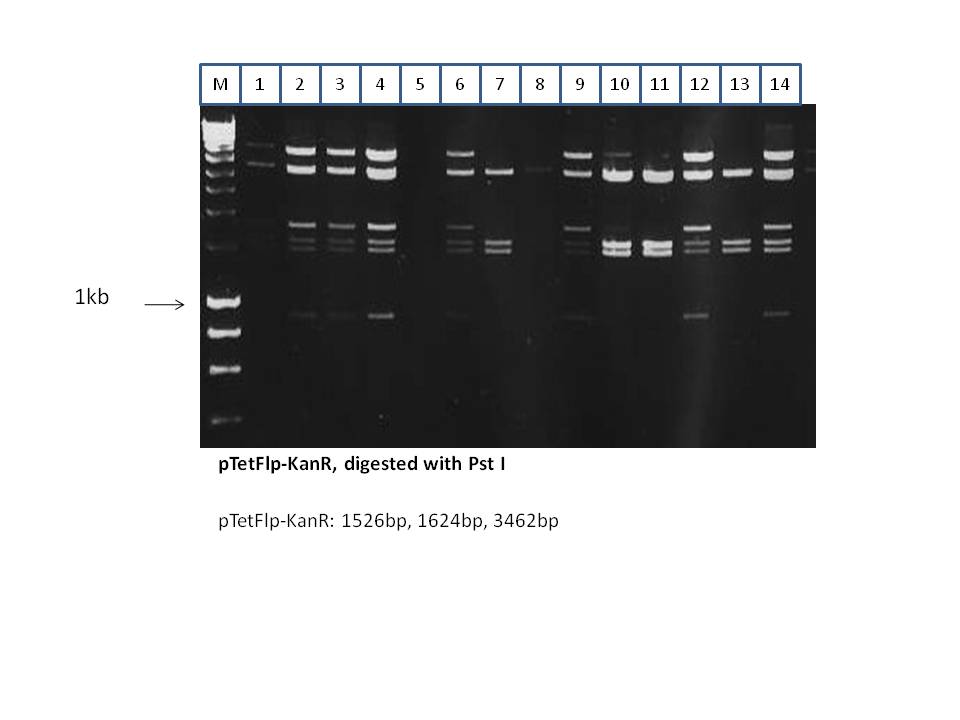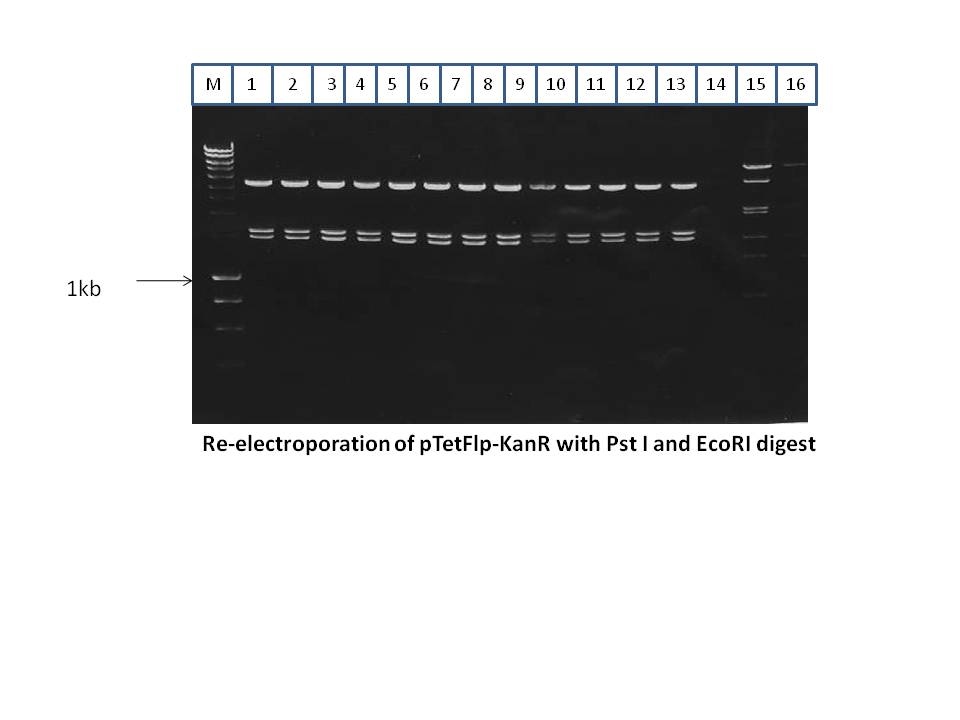Construction of pTetFlp
From 2009.igem.org
| Line 1: | Line 1: | ||
{{:Team:BIOTEC_Dresden/NewTemplate}} | {{:Team:BIOTEC_Dresden/NewTemplate}} | ||
[[Image:PTetFlp1.jpg|500px|]] | [[Image:PTetFlp1.jpg|500px|]] | ||
| + | |||
| + | As shown above the kan.gcc which encodes for kanamycin resistance was amplified from the Pirate-km.gcs plasmid (from Stewart lab). This Kan gene has homology arms to enable its introduction into the pRedFlp plasmid (from Stewart lab) by Red/ET recombination. The pTetFlp KanR has a pSC101 temperature sensitive origin (grows at 30°C but not at 37°C). The PCR product was isolated and purified from the gel. The gel was as shown below | ||
| + | |||
| + | [[Image:PCR_product_of_pR6K-KanR.JPG|500px|]] | ||
| + | |||
| + | Red/ET was done to introduce the KanR gene into the pTetFlp. The resulting plasmid was named pTetFlp KanR. This was digested with PstI, and showed the following results | ||
| + | |||
| + | [[Image:PTetFlp-KanR%2C_digested_with_Pst_I.JPG|500px|]] | ||
| + | |||
| + | From the 14 minis, 3 correct clones were re-electroporated, in order to purify it. This is a high copy plasmid and the first step of Red/Et mostly results in a mixture of the original plasmid and the desired plasmid. Re-electroporation and transformation results in purer products. 16 minis were done, of which 13 were correct, as shown below | ||
| + | |||
| + | [[Image:Re-electroporation_of_pTetFlp-KanR_with_Pst_I_and_EcoRI_digest.JPG|500px|]] | ||
| + | |||
[[Image:PTetFlp2.jpg|500px|]] | [[Image:PTetFlp2.jpg|500px|]] | ||
| + | |||
| + | As shown in the strategy above, pTetFlp KanR was digested using XhoI in order to linearize it. | ||
| + | |||
| + | F3-ZeoR-F3-RFP (plasmid ordered from GeneArt), is as shown in Fig 3. This when digested using PvuII resulted in the fragment shown in fig 4. It carries a zeocin resistance gene (ZeoR). The ZeoR gene is flanked by F3 sites that are similar to the FRT sites (vary in few bases) and is hence recognized and excised by Flippase. Therehe second F3 site is followed by a RFP gene. | ||
{{:Team:BIOTEC_Dresden/NewTemplateEnd}} | {{:Team:BIOTEC_Dresden/NewTemplateEnd}} | ||
Revision as of 14:08, 18 October 2009
As shown above the kan.gcc which encodes for kanamycin resistance was amplified from the Pirate-km.gcs plasmid (from Stewart lab). This Kan gene has homology arms to enable its introduction into the pRedFlp plasmid (from Stewart lab) by Red/ET recombination. The pTetFlp KanR has a pSC101 temperature sensitive origin (grows at 30°C but not at 37°C). The PCR product was isolated and purified from the gel. The gel was as shown below
Red/ET was done to introduce the KanR gene into the pTetFlp. The resulting plasmid was named pTetFlp KanR. This was digested with PstI, and showed the following results
From the 14 minis, 3 correct clones were re-electroporated, in order to purify it. This is a high copy plasmid and the first step of Red/Et mostly results in a mixture of the original plasmid and the desired plasmid. Re-electroporation and transformation results in purer products. 16 minis were done, of which 13 were correct, as shown below
As shown in the strategy above, pTetFlp KanR was digested using XhoI in order to linearize it.
F3-ZeoR-F3-RFP (plasmid ordered from GeneArt), is as shown in Fig 3. This when digested using PvuII resulted in the fragment shown in fig 4. It carries a zeocin resistance gene (ZeoR). The ZeoR gene is flanked by F3 sites that are similar to the FRT sites (vary in few bases) and is hence recognized and excised by Flippase. Therehe second F3 site is followed by a RFP gene.
 "
"









